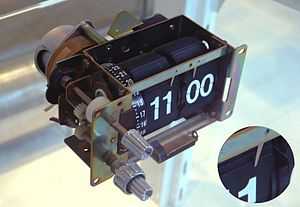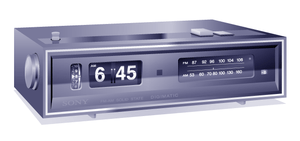Flip clock

An analog clock with digital display (commonly referred to as a "flip clock") is a clock which displays information in a digital format on a split flap display, but actually keeps track of the time in an analog fashion.
Method of operation
An electric motor (often synchronous, if directly connected to the AC line) turns two sets of wheels continuously via a reduction gear train: the faster at a rate of 1 revolution per hour, the slower at a rate of 1 revolution per 24 hours. The wheels move continuously, not in steps.

The faster wheel has connected to it a ring of 60 flat plastic leaves. On the leaves are printed numerals so that, when a person holds two adjacent leaves apart like an open book, the two open leaves spell out a numeral, and flipping a leaf down increases the number shown by 1 unit. The "book" is opened vertically, and its pages form a ring. This ring is put into position and rotated so that one page falls each minute, showing a new number for the minutes.
The slower wheel has connected to it a similar ring of leaves, only there are 48 leaves on this ring. These leaves have hour numbers printed on them. There are two of each hour, like this: 12am, 12am, 1am, 1am, 2am, 2am, ... 11pm, 11pm. One leaf falls each half-hour, at approximately 25 and 55 minutes after the hour. A different design features 60 leaves with the numbers 1 to 12 repeated in fives, each leaf falling after 12 minutes. The disadvantage of this is that there is no way to show "AM" or "PM" information.
Minute leaves 45 through 59 have a small tooth on them. The purpose of this tooth is as follows: at 45 minutes after the hour, the tooth pushes a lever that protrudes into the hour wheel area. This lever will catch any falling hour leaf, so that it will hold the current hour leaf in place until it is time for the new hour to start.
Daylight Saving Time

Analog clocks with digital displays cannot be wound back, as the flip mechanism operates only in one direction. Instead they must be wound forward 23 hours to achieve the effect of winding back 1 hour at the end of daylight saving time, or by stopping it for an hour. However, on some newer clocks, forward and backward time setting is possible. GE clocks sometimes had this feature.
See also
- Cifra 3
- Split flap display
- Digital sundial